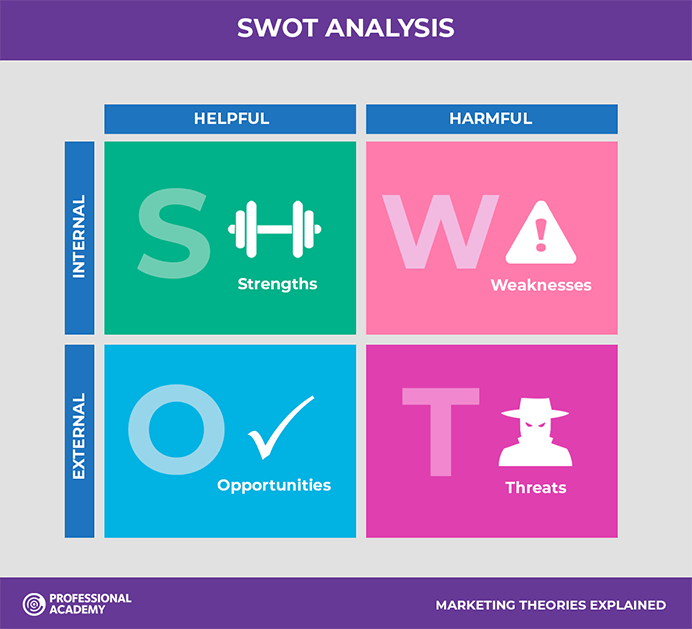
Click the button to start reading
How to Perform a SWOT Analysis in Project Management
Developed back in the 1960s, it soon became a widely used technique among project managers. What made it so popular was the combination of two important characteristics – it was simple yet powerful. More importantly, you didn’t have to be an expert to use it!
The technique, known as SWOT analysis, was designed by Albert Humphrey – an American business consultant. Since its creation, SWOT analysis has helped project managers develop an organized list of four critical factors that have an impact on their businesses. Humphrey realized that a successful examination of those factors could help make sound business decisions and assist with project management efforts.

What is SWOT analysis?
SWOT analysis is a technique used to analyze the current situation and come up with a strategic plan.
A thoughtful implementation of this tool allows you to assess areas that work well and identify the pitfalls that need your attention.
SWOT analysis is also a potent process for strategic goal-setting because it helps a team pave a clear path to action.
In this article, you’ll learn about the purpose of SWOT analysis in project management, get helpful tips, and take a specific example to guide your own process of planning.
But first, it’s helpful to learn what SWOT stands for.
What does SWOT stand for?
SWOT analysis involves outlining the Strengths, Weaknesses, Opportunities, and Threats of a project, product, or service. Hence, the acronym. Below is an overview of what each means for your strategic plan.
Strengths include any characteristics that make the project likely to succeed (positive work culture, experienced team, unique expertise in a field, hard-to-imitate customer service, etc.). Strengths are integral to your company and give you a competitive advantage by setting your business up for success. As these are internal factors, you have more control over them.
Weaknesses are internal factors that create disadvantages to your business and may hinder a project’s implementation. Typically, these are the areas for improvement. You may find weaknesses in your procedures, systems, use of technology, employee expertise, etc. The good news is – done successfully, the SWOT analysis can help you turn your weaknesses into an operational goal, a hiring plan, or other initiatives.
Opportunities are favorable external factors (outside of your control) that can help you gain an advantage or allow your project to succeed. A recently launched software tool, a special offer, or an easing of covid restrictions – all can be considered to be opportunities you’ll want to use to your benefit. Remember, opportunities are your growth goals.
Threats: These are external factors you can’t directly control. They could harm your project if they were to take place. As with opportunities, threats can be current or future. For example, the Covid pandemic caused massive supply chain disruptions that have posed challenges to workflow, budgeting, delivery, scheduling, employment, and more aspects of project management.

What is SWOT analysis in project management?
If business owners use the SWOT analysis to assess different areas of their companies, project managers use the same tool to identify actionable goals for their projects. Think of it as the first step in planning when you need to account for potential risks, address limitations, and identify the strengths you can rely on.
Who is involved in conducting a SWOT analysis?
To make accurate decisions, you’ll need a precise assessment of all four aspects of your project. Consequently, it’s essential to have a diverse and representative team working on the SWOT analysis. For example, you’ll get better information from a group that includes folks from customer service, sales, and marketing departments than if you involve only the marketing team in this process.
From a project management perspective, it’s vital to collect complete and unbiased information. Questions may arise that aren’t clear enough and require additional input. To ensure nothing is overlooked, you can think of including viewpoints from customers, sponsors, service providers, and other stakeholders, too.
Strategic planning is an important part of project management. When you involve all interested parties, you also promote transparency, collaboration, and teamwork – something you want to maintain across time and projects.
How to do the SWOT analysis?
SWOT analysis starts with identifying and analyzing the forces that affect your project. At this stage, you may want to create a SWOT matrix or a document with four columns to help you with the planning.

Source: Professional Academy
It’s useful to gain an insight into the process steps, so let’s delve in.
- Brainstorm: Great planning starts with creating a systematized view of your current state. Come together with your team and brainstorm a list for each of the four categories above (strengths, weaknesses, opportunities, and threats). Ask your teammates to come prepared to share ideas and ask questions.
- Prioritize: Time to organize the factors into a priority list. The most critical points in each section should go first, while the least important ones should be placed at the bottom. Keep all the points from your brainstorming session, but note that you can’t possibly address every single factor on the chart. Prioritization will help to determine which factors need your immediate attention, which ones require your constant input, and which ones can wait up until a more suitable time.
- Create an action plan: Now that you’ve analyzed your strengths and weaknesses as well as outlined the opportunities and threats, it’s time to create your action plan. A carefully boiled-down SWOT plan is the best way to balance priorities and give you a good starting point in managing your project.
- Review and assess: Although a SWOT analysis is part of your strategic planning and won’t be subject to constant changes, there are certain things you’ll have to watch out for. If you’re performing a SWOT analysis in project management, review the analysis after the project is complete. Maybe you weren’t successful at mitigating some of the threats. Maybe some weaknesses have changed into strengths! Recognize those changes and use them to your advantage.
A pro tip before we proceed: researchers Laurence Minsky and David Aron have found that it’s more effective to start with the external factors: you first collect information about opportunities and threats and only then turn to the internal ones.

A SWOT project management example
Time to put everything into practice.
Let’s suppose you’re trying to develop a SWOT analysis for your next marketing project for your jewelry brand. Your competitor has introduced a new product to the market that’s outperforming your own.
Here’s your completed SWOT matrix after the brainstorming session:
Strengths
- You have people with unique expertise in traditional design.
- You have a good reputation in the marketplace.
- You offer top-class customer service.
- You have good technology.
- You have a good location in the city center that draws in foot traffic.
- Your product stands out with its unique traditional design.
- You effectively use social media channels to generate buzz about your brand.
Weaknesses
- Your website visibility is low due to a lack of budget.
- You can’t handle too many projects at a time; tight deadlines are always a challenge for your team.
- You lack funding to launch a big, conceptually complete product.
- Underused option of online ordering.
Opportunities
- Your competitor is not as effective on social media as you are.
- There is an untapped market targeting women over age 50.
- The jewelry industry is expected to grow in the upcoming 2-3 years because of local events and festivals. A good presence by the time these events start could help to expand the brand’s reach among locals and tourists.
Threats
- The competitor’s product is out there, and you can’t take it away!
- You have team members who are basically irreplaceable. You can’t lose them.
- Due to the evolving covid situation, you may (again) witness supply chain disruptions.
- Supply chain disruptions may also affect raw material prices.
- The competitor may copy or imitate the design.
- There can be new competitors coming into the market.
Congratulations! The brainstorming session has been quite effective! Project SWOT analysis examples like this should help you build on your strengths, reinforce your weaknesses, invest in opportunities, and keep track of the threats.

The action plan for your project
Be careful. The SWOT analysis is not your plan; you’re going to use the SWOT analysis to create the action plan for your project. Based on the analysis above, we proceed with creating the action plan. Here’s an example:
- To invest in a new product line targeting women over age 50.
- To run a patent for colors and ornaments before releasing the product line.
- Meet with department stakeholders to explore the opportunities of obtaining capital from interested investors.
- Build relationships with distributors to mitigate the risk of supply chain disruptions.
- Use a brand face for the new product line.
- Run ad campaigns on Facebook and Instagram.
- Attend an upcoming fashion and design conference to get inspiration and fresh ideas.
That’s it. Your team is now ready to go!
Conclusion
SWOT analysis in project management is not a task to be completed and forgotten. It’s a powerful tool to visualize the most important details of your project and balance the most critical factors affecting the entire organization. It’s an honest assessment of your strengths and weaknesses, opening doors to new perspectives and solutions.
Use the tool smartly to get accurate answers, guard you against any challenges, and spark growth for your business!
















